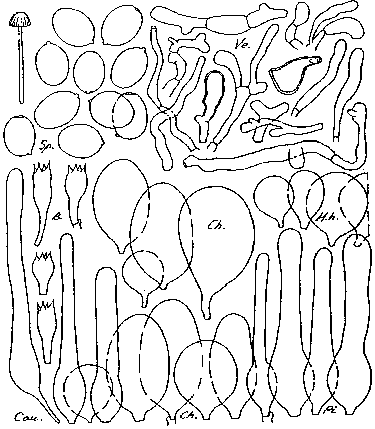Macroscopic features |
Closed pileus up to 4 x 3 mm, at centre cinnamon, towards margin paler, soon grey, up to c. 7 mm wide when expanded. Veil present on pileus, visible as small, whitish, radial fibrillose flocks. Lamellae narrowly adnate; L= 8-13, l= 0-1. Stipe 8-20 x 0.1-0.5 mm, whitish, vitreous, with widely dispersed setulae. |
Microscopic features |
Spores [40,2,1] 7.0-8.5 x 5.1-6.2 µm, av. L= 7.4-8.1, av. B= 5.5-5.7 µm, Q= 1.25-1.60, av. Q= 1.35-1.40, broadly ellipsoid, ellipsoid to ovoid; germ pore central, 1.6 µm wide. Basidia 16-40 x 8-11 µm, 4-spored. Pseudoparaphyses not noted. Cheilocystidia 20-50 x 20-30 µm, vesiculose. Pleurocystidia absent. Pileocystidia 50-100 x 14-22 µm, (broadly) lageniform with 7-12 µm wide, equal to slightly subcapitate apex. Sclerocystidia absent. Veil on pileus of somewhat diverculate 2-8 (-10) µm broad hyphae. Clamp-connections present. |
Habitat |
On sandy-clayey soil, among or on wood-chips. Solitary or a few together. |
Remarks |
In this species particularly the shape and the size of the spores are characteristic. None of the other species with cylindrical veil elements has spores as small as Uljé 926. The central germ pore is the most important difference with other species (except C. hiascens) which possess cylindrical veil elements. Coprinus hiascens, however, has spores with a conical apex, lageniform cheilocystidia and tapering pileocystidia, whereas Uljé 926 has spores with a rounded apex, vesiculose cheilocystidia and pileocystidia, that are broadened at the apex. Because of the very small size of the fruit-bodies and the greyish colour of the pileus this species is very inconspicuous and difficult to find. |

[Copyright © by Uljé]